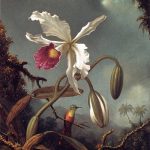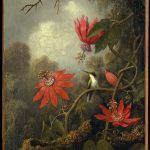
Martin Johnson Heade was not a famous artist during his time, and for much of the first part of the 20th century was nearly forgotten. A re-awakening of interest in 19th-century American art around World War II sparked a new appreciation of his work. Heade’s work in particular received critical attention with the exhibition in 1943 of his painting Thunderstorm Over Narragansett Bay (1868), as part of the show “Romantic Painting in America” at the Museum of Modern Art. Art historians have come to consider him one of the most important American artists of his generation. His work has inspired contemporary artists such as David Bierk and Ian Hornak.
His works are in most major American museums, including the Museum of Fine Arts in Boston, Massachusetts, which owns the nation’s most outstanding collection of his works, including about 30 paintings as well as numerous drawings and sketchbooks; the Metropolitan Museum of Art in New York City; and the National Gallery of Art in Washington, D.C.
The Big Donation
In 1955, Robert McIntyre, art historian and director of the Macbeth Gallery, donated a cache of Heade’s personal papers to the Archives of American Art, part of the Smithsonian Institution. These papers included, among other things, Heade’s sketchbook, notes, and letters from his friend and fellow artist Frederic Edwin Church. In 2007, these papers were digitized and made accessible on the Web.
In 1999 and 2000, Heade was the subject of a major exhibition organized by Theodore E. Stebbins, Jr. It traveled from the Museum of Fine Arts in Boston to the National Gallery of Art in Washington, ending at the Los Angeles County Museum of Art.
In 2004, Heade was honored with a stamp from the U.S. Postal Service featuring his 1890 oil-on-canvas painting, “Giant Magnolias on a Blue Velvet Cloth.” As Stebbins notes in his writings, Heade’s work has also been copied and forged extensively. Since Heade was not popular during his lifetime, there were few contemporaries who emulated his work. 20th-century copies are therefore readily apparent as fakes since it takes oil paint decades to dry out and harden. Source: Wikipedia.



